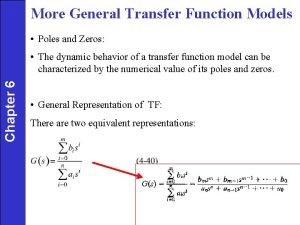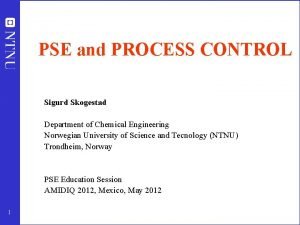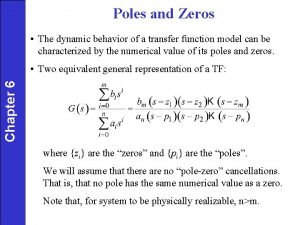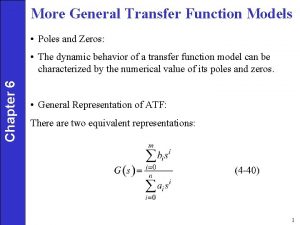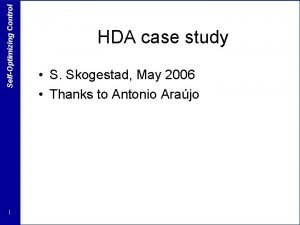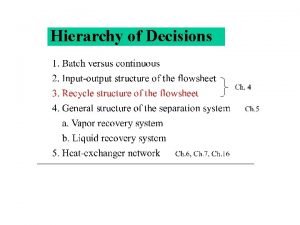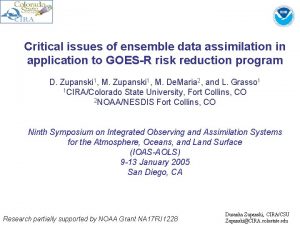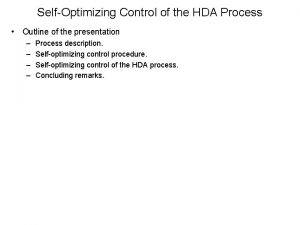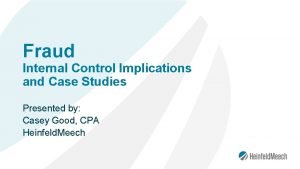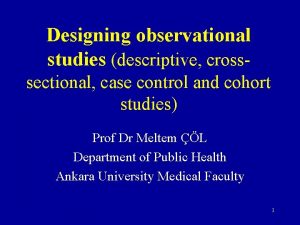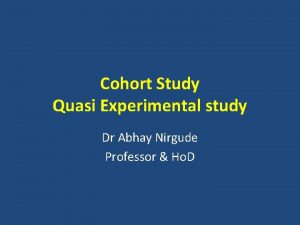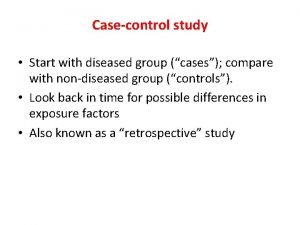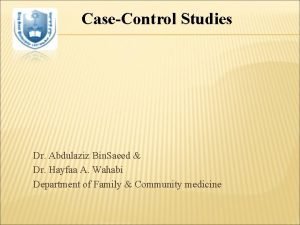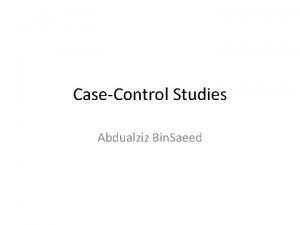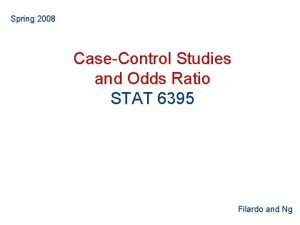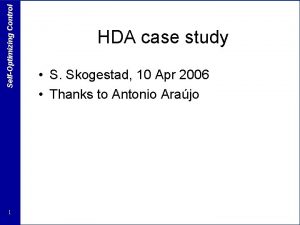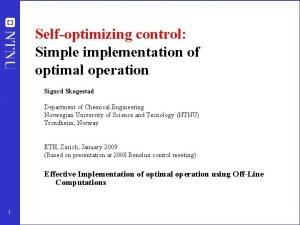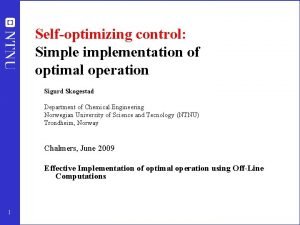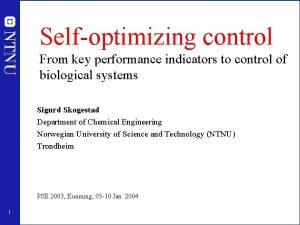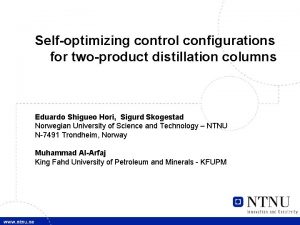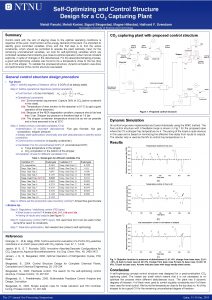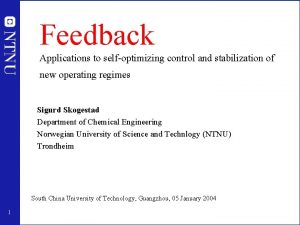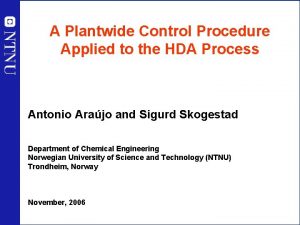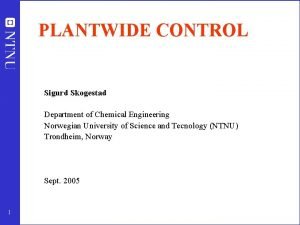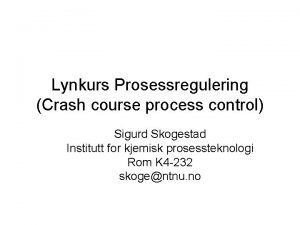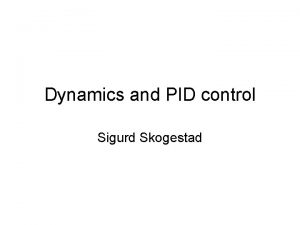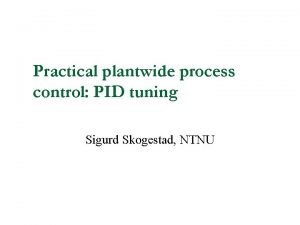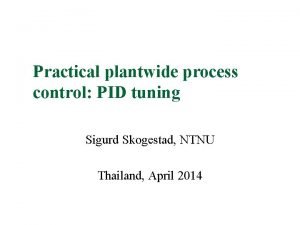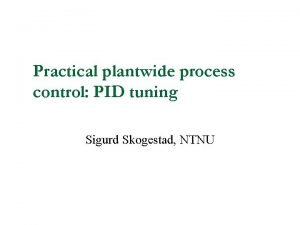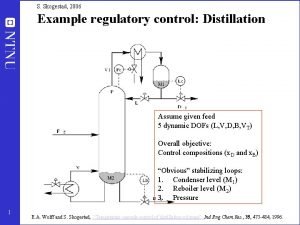SelfOptimizing Control 1 HDA case study S Skogestad


























- Slides: 26

Self-Optimizing Control 1 HDA case study • S. Skogestad, May 2006 • Thanks to Antonio Araújo

Self-Optimizing Control Process Description • Benzene production from thermal-dealkalination of toluene (hightemperature, non-catalytic process). • Main reaction: CH 3 + H 2 → • Side reaction Benzene Toluene 2 + CH 4 + Heat + H 2 → ← Diphenyl 2 • Excess of hydrogen is needed to repress the side reaction and coke formation. • References for HDA process: • Mc. Ketta (1977) – first reference on the process; • Douglas (1988) – design of the process; • Wolff (1994) – discuss the operability of the process. • No references on the optimization of the process for control structure design purposes.

Self-Optimizing Control Process Description Purge (H 2 + CH 4) Compressor H 2 + CH 4 Toluene Mixer FEHE Toluene Furnace Benzene Toluene Column Diphenyl 3 Cooler PFR Quench Separator CH 4 Benzene Column Stabilizer

Self-Optimizing Control Steady-state operational degrees of freedom Process units DOF External feed streams (feed rate) 2 Heat exchangers duties (including 1 furnace) 3 Splitters 2 Compressor duty 1 Adiabatic flash(*) 0 Gas phase reactor(*) 0 Distillation columns 6 14 Equality constraint Quencher outlet temperature -1 Remaining degrees of freedom at steady state 13 (*) 4 No adjustable valves (assumed fully open valve before flash)

Self-Optimizing Control Steady-state operational degrees of freedom 8 Purge (H 2 + CH 4) Compressor 1 Furnace 3 H 2 + CH 4 Quencher Toluene Mixer FEHE 6 13 Toluene Reactor 4 2 Cooler 11 9 Benzene Toluene Column Benzene Column 14 CH 4 Stabilizer 12 5 Separator Diphenyl 5 7 10

Self-Optimizing Control 6 Cost Function and Constraints • The following profit is maximized (Douglas’s EP): -J = pben. Dben – ptol. Ftol – pgas. Fgas – pfuel. Qfuel – pcw. Qcw – ppower. Wpower - psteam. Qsteam + Σ(pv, i. Fv, i) • Constraints during operation: – – – – – Production rate: Hydrogen excess in reactor inlet: Bound on toluene feed rate: Reactor pressure: Reactor outlet temperature: Quencher outlet temperature: Product purity: Separator inlet temperature: + Distillation constraints Dben ≥ 265 lbmol/h. FHyd / (Fben + Ftol + Fdiph) ≥ 5. Ftol ≤ 300 lbmol/h. Preactor ≤ 500 psia. Treactor ≤ 1300 °F. Tquencher = 1150 °F. x. Dben ≥ 0. 9997. 95 °F ≤ Tflash ≤ 105 °F. • Manipulated variables are bounded.

Self-Optimizing Control Disturbances Disturbance Unit Nominal Lower Upper Toluene feed flow rate lbmol/h 300 285 315 Gas feed composition mol% of H 2 95 90 100 $/lbmol 9. 04 8. 34 9. 74 MBTU/lbmol 0. 1247 0. 12 0. 13 Benzene price Energetic value of fuel to the furnace 7

Self-Optimizing Control 8 Optimization Benzene price Disturbance

Self-Optimizing Control Optimization • 14 steady-state degrees of freedom • 10 active constraints: 1. 2. 3. 4. Pure toluene feed rate By-pass valve around FEHE Reactor inlet hydrogen-aromatics ratio Flash inlet temperature 5. Methane mole fraction in stabilizer bottom 6. Benzene mole fraction in stabilizer distillate 7. Benzene mole fraction in benzene column bottom 8. Toluene mole fraction in benzene column distillate 9. Toulene mole fraction in toluene column bottom 10. Diphenyl mole fraction in toluene column distillate • 1 equality constraint: 11. Quencher outlet temperature • 9 3 remaining unconstrained degrees of freedom. (UB) (LB) (UB) (UB)

Self-Optimizing Control Optimization – Active Constraints Purge (H 2 + CH 4) Compressor Furnace 2 H 2 + CH 4 Quencher Toluene Mixer FEHE Reactor 3 1 Cooler 8 10 6 Benzene Toluene Column 10 Equality 11 4 CH 4 Benzene Column Stabilizer Diphenyl 9 7 5 Separator

Self-Optimizing Control Candidate Controlled Variables • Candidate controlled variables: – Pressure differences; – Temperatures; – Compositions; – Heat duties; – Flow rates; – Combinations thereof. • 138 candidate controlled variables might be selected. • 14 degrees of freedom. • Number of different sets of controlled variables: • 10 active constraints + 1 equality constraint leaving 3 DOF: 11 • What should we do with the remaining 3 DOF? – Self-optimizing control!!!

Self-Optimizing Control Analysis of the linear model • Select 3 of 127 candidate measurements. • Scale variables properly and linearize. • Find max σ(G 3 x 3) by a branch-and-bound algorithm. • Alternatively, find max σ(G 3 x 3·Juu-1/2) by a branch-and-bound algorithm. “input scaling” • Calculate the loss by the exact local method for the most important disturbance: Namely, feed toluene rate. 12

Self-Optimizing Control 13 Analysis of the linear model a. All measurements: σ(Gfull) = 0. 0445; σ(G 3 x 3) = 0. 02382, Loss = 8. 6461 I Toluene column reflux flow rate II Compressor power III Liquid (cooling) flow to quencher σ(Gfull·Juu-1/2) = 0. 1695 σ(G 3 x 3·Juu-1/2) = 0. 10257, Loss = 6. 6803 I Toluene mole fraction in stabilizer bottom II Compressor power III Furnace heat duty σ(G 3 x 3) = 0. 02381, Loss = 8. 6474 σ(G 3 x 3·Juu-1/2) = 0. 10283, Loss = 6. 7837 Diphenyl mole fraction in benzene column bottom II Compressor power III Liquid (cooling) flow to quencher Toluene mole fraction in separator liquid outlet II Compressor power III Furnace heat duty σ(G 3 x 3) = 0. 02380, Loss = 8. 6475 σ(G 3 x 3·Juu-1/2) = 0. 10129, Loss = 8. 4168 Benzene mole fraction in benzene column bottom II Compressor power III Liquid (cooling) flow to quencher Diphenyl mole fraction in quencher outlet II Compressor power III Furnace heat duty

Self-Optimizing Control Self-optimizing variables II W Purge (H 2 + CH 4) Compressor Furnace 2 H 2 + CH 4 11 Quencher Toluene Mixer FEHE 1 10 I L III Q 1 Cooler 8 6 Benzene Toluene Column Reactor F III 4 Separator CH 4 Benzene Column Stabilizer I xtol 14 Optimal set Diphenyl 9 7 5

Self-Optimizing Control Analysis of the linear model b. Distillation train excluded and separator pressure constant (controllability): σ(Gfull) = 0. 0440; σ(Gfull·Juu-1/2) = 0. 1663 σ(G 3 x 3) = 0. 02240, Loss = 7. 9683 σ(G 3 x 3·Juu-1/2) = 0. 08971, Loss = 7. 9683 I Toluene mole fraction in separator liquid outlet II Compressor power III Separator pressure σ(G 3 x 3) = 0. 02266, Loss = 8. 9112 Benzene mole fraction in mixer outlet Compressor power Separator pressure σ(G 3 x 3) = 0. 02265, Loss = 8. 9290 Quencher outlet diphenyl mole fraction Compressor power Separator pressure outlet II Compressor power III Separator pressure σ(G 3 x 3·Juu-1/2) = 0. 08612, Loss = 8. 9112 Benzene mole fraction in mixer outlet Compressor power Separator pressure σ(G 3 x 3·Juu-1/2) = 0. 08598, Loss = 8. 9290 Quencher outlet diphenyl mole fraction Compressor power Separator pressure Note: The two methods give the same order in this case 15

Self-Optimizing Control Alternative self-optimizing variables II W Compressor Furnace 2 H 2 + CH 4 11 Quencher Toluene Mixer FEHE Reactor 1 1 P III Cooler 8 10 6 Benzene Toluene Column 16 Purge (H 2 + CH 4) 4 CH 4 Benzene Column xtol I Stabilizer Diphenyl 9 7 Separator 5

Self-Optimizing Control Conclusion steady-state analysis • Many similar alternatives in terms of loss • Need to consider dynamics (Input-output controllability analysis): – RHP-zeros – RHP-poles – Input saturation – Easy of implementation (decentralized control of final 3 x 3 supervisory control problem)! • Now: Consider “bottom-up” design of control system 17

Self-Optimizing Control Bottom-up design of control system • Start with stabilizing control – Levels – Pressure – Temperatures • Normally start with fastest loops (often pressure) – but let is start with levels 18

Self-Optimizing Control “Bottom-up”: Proposed Control Structure Stabilizing Control: Control 7 liquid levels Purge (H 2 + CH 4) Compressor Furnace H 2 + CH 4 Toluene Quencher Mixer FEHE Reactor Cooler LC Separator LC LC Benzene Toluene Column LC 19 Diphenyl LC CH 4 Benzene Column LC Stabilizer LC LV-configuration assumed for columns

Self-Optimizing Control Avoiding “Drift” I – 4 Pressure loops Pressure with purge Purge (H 2 + CH 4) Compressor Furnace H 2 + CH 4 Toluene Quencher Mixer FEHE Reactor Cooler PC LC Benzene Toluene Column LC 20 Diphenyl PC LC CH 4 Benzene Column LC Stabilizer LC Column pressures are given Separator

Self-Optimizing Control Avoiding “Drift” II – 4 Temperature loops Purge (H 2 + CH 4) Compressor Furnace H 2 + CH 4 Toluene Quencher Mixer FEHE TC Ts Reactor ps Cooler PC LC Benzene Toluene TC Toluene Column TC Benzene Column Separator PC LC CH 4 Stabilizer TC LC 21 Diphenyl LC LC

Self-Optimizing Control 22 Now suggest pairings for supervisory control

Self-Optimizing Control of 11 active constraints. Purge (H 2 + CH 4) Compressor FC SP SP CC Furnace SP TC H 2 + CH 4 Quencher Toluene Mixer FEHE Ts TC Reactor ps FC Cooler PC SP LC TC PC LC Benzene Toluene SP CC TC SP Toluene Column LC Diphenyl CC TC SP CH 4 SP Separator CC Stabilizer CC LC PC LC Benzene Column CC 23 PC LC SP TC SP LC CC SP methane 3 DOF left

Self-Optimizing Control of 3 self-optimizing variables: Optimal set II Purge (H 2 + CH 4) Compressor FC SP SP CC Furnace SP TC H 2 + CH 4 Quencher Toluene Mixer FEHE FC Ts TC III Q Reactor ps Cooler PC SP LC TC PC LC Benzene Toluene SP CC TC SP Toluene Column LC Diphenyl CC TC SP CH 4 SP Separator CC Stabilizer CC LC PC LC Benzene Column CC 24 PC LC SP TC SP CC SP methane LC I xtoluene Supervisory control problem seems difficult

Self-Optimizing Control of 3 self-optimizing variables: Alternative set: SIMPLE II Purge (H 2 + CH 4) Compressor FC SP SP CC Furnace SP TC H 2 + CH 4 Quencher Toluene Mixer FEHE Ts TC Reactor FC Cooler PC SP LC TC PC LC SP CC TC SP Toluene Column LC CC TC CH 4 SP SP Separator CC I xtol Stabilizer CC LC SP PC LC Benzene Column CC Diphenyl PC LC Benzene Toluene 25 III ps TC SP CC SP LC Could control another composition, e. g. quencher outlet diphenyl

Self-Optimizing Control 26 Conclusion HDA • Follow systematic procedure • May want to keep several candidate sets of “almost” self-optimizing variables • Final evaluation: Non-linear steady-state simulations + Dynamic simulations using Aspen (ongoing!)
 Skogestad half rule calculator
Skogestad half rule calculator Pse p&id
Pse p&id Skogestad half rule
Skogestad half rule General transfer function
General transfer function Hda process
Hda process Les joueurs de skat otto dix
Les joueurs de skat otto dix Histoire de guernica
Histoire de guernica Hda process
Hda process Obs hda
Obs hda What is hda
What is hda Hda process
Hda process Perfusion omeprazol hda
Perfusion omeprazol hda Hda affiche rouge
Hda affiche rouge Affiche rouge hda
Affiche rouge hda Best worst and average case
Best worst and average case Crm failure case study
Crm failure case study Internal control case study
Internal control case study Retrospective cohort study vs case control
Retrospective cohort study vs case control Case control vs retrospective cohort
Case control vs retrospective cohort Difference between case control and cohort study
Difference between case control and cohort study Case control study example
Case control study example Case control study example
Case control study example Nested case control
Nested case control Longitudinal prospective study
Longitudinal prospective study Nested case control study
Nested case control study Long case and short case
Long case and short case Image search
Image search
